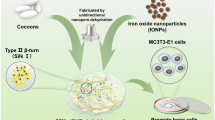Abstract
Hydroxyapatite due to its good biocompatibility and similar chemical composition to the mineral part of bone has found various applications in tissue engineering. Porous hydroxyapatite has high surface area, which leads to excellent osteoconductivity and resorbability, providing fast bone ingrowth. In this study, highly porous body of nanostructure hydroxyapatite was successfully fabricated via gelcasting method. The pure phase of hydroxyapatite was confirmed by X-ray diffraction. The result of scanning electron microscopy analysis showed that the prepared scaffold has highly interconnected spherical pores with a size in the range 100–400 μm. The crystallite size of the hydroxyapatite scaffold was measured in the range 30–42 nm. The mean values of true (total) and apparent (interconnected) porosity were calculated in the range 84–91 and 70–78%, respectively. The maximum values of compressive strength and elastic modulus of the prepared scaffold were found to be about 1.5 MPa and 167 MPa, respectively, which were achieved after sintering at 1,000 °C for 4 h. Transmission electron microscopy analysis showed that the particle sizes are smaller than 80 nm. In vitro test showed good bioactivity of the prepared scaffold. The mentioned properties could make the hydroxyapatite scaffold a good candidate for tissue engineering applications, especially applications that did not need to stand any loading.









Similar content being viewed by others
References
Le Huec JC, Schaeverbeke T, Clement D, Faber J, Le Rebeller A (1995) Influence of porosity on the mechanical resistance of hydroxyapatite under compressive stress. Biomater 16:113–118
Gauthier O, Bouler J, Aguado E, Pilet P, Daculsi G (1998) Macroporous biphasic calcium phosphate ceramics: influence of macropore diameter and macroporosity percentage on bone ingrowth. Biomater 19:133–139
Yoshikawa H, Myoui A (2005) Bone tissue engineering with porous hydroxyapatite ceramics. J Artif Organs 8:131–136
Vacanti C, Vacanti J (1994) Bone and cartilage reconstruction with tissue engineering approaches. Otolaryngol Clin North Am 27:263–276
Vacanti CA, Bonassar LJ (1999) An overview of tissue engineered bone. Clin Orthop 367:375–381
Levine JP, Bradly J, Turk AE, Ricci JL, Benedict JJ, Steiner G et al (1997) Bone morphogenetic protein promotes vascularization and osteoinduction in preformed hydroxyapatite in the rabbit. Ann Plastic Surg 39:258–268
Freidman CD, Costantino PD, Takagi S, Chow LC (1998) Bone source hydroxyapatite cement: a novel biomaterial for craniofacial skeletal tissue engineering and reconstruction. J Biomed Mater 43:428–432
Peppas NA, Langer R (1994) New challenges in biomaterials. Science 263:1715–1720
Lauffenburger DA (1994) Cell engineering. In: Bronzine JD (ed) The biomedical engineering handbook. CRC Press, Boca Raton
Kon E, Muraglia A, Corsi A, Bianco P, Marcacci M, Martin I et al (2000) Autologous bone marrow stromal cells loaded onto porous hydroxyapatite ceramic accelerate bone repair in critical-size defects of sheep long bones. J Biomed Mater 49:328–337
Gu J, Xie J (2002) Experimental study on stimulation of guided bone regeneration by autogenous bone marrow. Chinese J Repar Reconst Surg 16:112–113
Jie Q, Dai X, Cao Q (2002) Massive allograft for defects after bone malignant tumor resection. Chinese J Modern Med 12:60–62
Lee FY, Hazan EJ, Gebhardt MC, Mankin HJ (2000) Experimental model for allograft incorporation and allograft fracture repair. J Orthop 18:303–306
Ramay HR, Zhang M (2003) Preparation of porous hydroxyapatite scaffolds by combination of the gel-casting and polymer sponge methods. Biomater 24:3293–3302
Sopyan I, Mel M, Ramesh S, Khalid KA (2007) Porous hydroxyapatite for artificial bone applications. Sci Technol Adv Mater 8:116–123
Sepulveda P, Binner JGP, Rogero SO, Higa OZ, Bressiani JC (2000) Production of porous hydroxyapatite by the gel casting of foams and cytotoxic evaluation. J Biomed Mater Res 50:27–34
Chen B, Zhang Z, Zhang J, Dong M, Jiang D (2006) Aqueous gel-casting of hydroxyapatite. Mater Sci Eng A 198:435–436
Potoczek M (2008) Hydroxyapatite foams produced by gelcasting using agarose. Mater Lett 62:1055–1057
Sepulveda P, Ortega FS, Innocentini MDM, Pandolfelli VC (2000) Properties of highly porous hydroxyapatite obtained by the gelcasting of foams. J Am Ceram Soc 83:3021–3024
Tang YJ, Tang YF, Lv CT, Zhou ZH (2008) Preparation of uniform porous hydroxyapatite biomaterials by a new method. Appl Surface Sci 254:5359–5362
Wei GB, Pettway GJ, McCauley LK, Ma PX (2004) The release profiles and bioactivity of parathyroid hormone from poly (lactic-co-glycolic acid) microspheres. Biomater 25:345–352
Du C, Cui FZ, Zhu XD, De Groot K (1999) Three-dimensional nano-HAp/collagen matrix loading with osteogenic cells in organ culture. J Biomed Mater 44:407–415
Ferraz MP, Monteiro FJ, Manuel CM (2004) Hydroxyapatite nanoparticles: a review of preparation methodologies. J Appl Biomater Biomech 2:74–80
Cullity BD (1978) Elements of X-ray diffraction, 2nd edn. Addison-Wesley, Boston, USA
Askeland DR (1989) The science and engineering of materials, 2nd ed. PWS Pub.Co, Boston
Kokubo T, Takadama H (2006) How useful is SBF in predicting in vivo bone bioactivity? Biomater 27:2907–2915
Potoczek M, Zima A, Paszkiewicz Z, Slosarczyk A (2009) Manufacturing of highly porous calcium phosphate bioceramics via gel-casting using agarose. Ceram Int 35:2249–2254
Webster TJ, Siegel RW, Bizios R (2001) Enhanced surface and mechanical properties of nanophase ceramics to achieve orthopaedic/dental implant efficacy. Key Eng Mater 192–195:321–324
Webster TJ, Siegel RW, Bizios R (2000) Enhanced functions of osteoblasts on nanophase ceramics. Biomater 21:1803–1810
Webster TJ, Ergun C, Doremus RH, Siegel RW, Bizios R (2000) Specific proteins mediate enhanced osteoblast adhesion on nanophase ceramics. J Biomed Materi Res 5:475–483
Fathi MH, Hanifi A, Mortazavi V (2008) Preparation and bioactivity evaluation of bone-like hydroxyapatite nanopowder. J Mater Process Technol 202:536–542
Fathi MH, Hanifi A (2007) Evaluation and characterization of nanostructure hydroxyapatite powder prepared by simple sol-gel method. Mater Lett 67:3978–3983
Oh S, Oh N, Appleford M, Ong JL (2006) Bioceramics for tissue engineering applications. Am J Biochem Biotechnol 2:49–56
Acknowledgments
The authors are grateful to Isfahan University of Technology for supporting this research.
Author information
Authors and Affiliations
Corresponding author
Rights and permissions
About this article
Cite this article
Ghomi, H., Fathi, M.H. & Edris, H. Preparation of nanostructure hydroxyapatite scaffold for tissue engineering applications. J Sol-Gel Sci Technol 58, 642–650 (2011). https://doi.org/10.1007/s10971-011-2439-2
Received:
Accepted:
Published:
Issue Date:
DOI: https://doi.org/10.1007/s10971-011-2439-2




